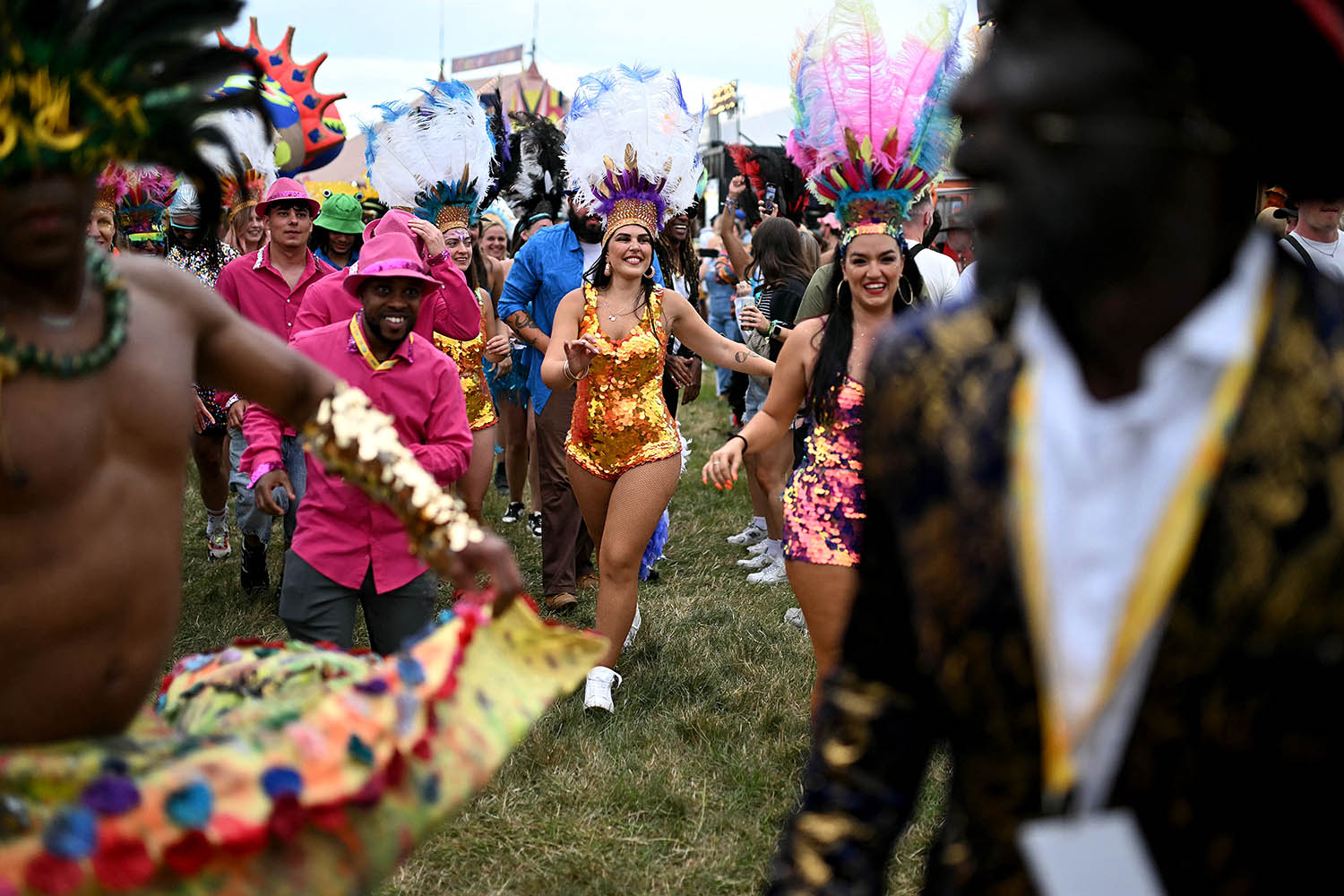It’s the Wednesday before Glastonbury and I’m trying on hats. I pick up a straw Panama and pose for my wife. “I’m worried it might make me look … middle-aged.”
“You are middle-aged,” she replies, destroying my ego before I’ve even asked if the baker boy cap is “too Super Mario”.
Going to Glastonbury for the first time in exactly 30 years is a lesson in humility as well as fashion. My last time at the pop festival, as a university graduate in 1995, defined the break between childhood and adult life, at a moment when the world was halfway between the Cold War and the War on Terror, hopeful that things were finally getting better without knowing they might also get a lot worse.
A generation later that naïve confidence has returned as a mid-life crisis, so here I am, cosplaying my youth in a rainbow, tie-dyed Camembert Electrique t-shirt. Nothing is more Glastonbury than Planet Gong, and since I’m an old hand, I’m sure it will fit the Glasto vibe perfectly alongside the rasta hats, dreadlocks and Bob Marley-themed clothes stalls.
What isn’t in the Glasto vibe is my wife’s insistence on forward planning – the curse of modern life. I spent the weekend in our back garden putting up the stupidly enormous tent we’ve bought, for practice. When I object to the idea of bringing an Esky full of cider, my appetite for spontaneity sounds like Trussian recklessness. Maybe she has a point. After all, how the hell will I charge my phone? Do I need cash? And where do I even get cash these days?
But she is more worried that there will be no space when we arrive, due to family commitments, early on Thursday morning. I put on my reassuring voice. “We’ll probably be some of the first ones there.”
Thursday
The festival crew member looks at the map. “Well,” she says. “You might get lucky here” pointing at a camping field that has 90% on it, rather than 95% like most of the others. “Or there’s always Lime Kiln Field.” That’s 65% full, about a mile away, and uphill.
An hour later, cursing the weight of the tent and slab of cider, we have arrived at our temporary home. In 1995, you could pay your £65 in advance, or find a tout at Castle Cary station, or look for a gap in the fence. Wandering the perimeter at midnight on Thursday, we were about to give up when another lost soul asked for directions, claiming to be a journalist from Just Seventeen. At the press entrance, it turned out he really was a music journalist; better still, the security team waved in the two scruffy souls behind him and we pitched up not far from the Pyramid Stage.
These days, it’s probably easier to start a magazine to get a media pass than jump the fence. Most of the people here are veterans of the forward planning arms race that involves forming a syndicate, choosing the optimal browser extension, and heading in to use the office wifi at 8am on a Sunday.
Being back brings with it a lot of psychogeographical imbalance. The Pyramid Stage is in the same place, and there are still lots of food stalls behind it, but otherwise I’m lost. At 55, Glastonbury is a victim of middle-age spread. It may be more polished, better organised and maybe a bit comfier, but it’s definitely bulkier: the 1995 programme offered 1,000 acts and “at least” 17 stages; this year there were 95 stages hosting more than 2,500 acts. The choice is bewildering. What are Silver Hayes, Shangri-La, West Holts and Block9? The young people seem to know, and for all the talk of people taking the grandkids to Glasto, there’s certainly a lot more twentysomethings than any other demographic.
Friday
It seems the young people are also cosplaying my youth. The average age at Fabio and Grooverider’s orchestral show and Carl Cox’s mobile disco can’t be more than 25, and they know all the lyrics and drops to all the 1990s club classics. Dance music is far bigger now than when I stumbled across a stall in 1992 and couldn’t work out how the DJ was playing dub reggae and hardcore techno at the same time. Now jungle is in the midst of a revival. House has never needed it, since every 16-bar loop seems to echo or steal a previous one and Fatboy Slim’s set is a masterclass in making familiar samples seem new.
Young people are meant to be the epitome of the new Britain: health-conscious, abstemious, censorious and risk-averse – middle-aged traits, perhaps – but not these ones. The dance floor is carpeted with enough nitrous oxide canisters to power a maternity unit and you’re never more than five metres from a bag of white powder and a tiny spoon to snort it. There’s no sign of anyone flogging ecstasy, speed or acid, though, fewer whiffs of cannabis than in central London and not even any stalls selling Rizlas.
Saturday
Three days in, and after handing over £32 for two bowls of jerk chicken and rice, I clutch my still-cold Esky cider – turns out forward planning is not all bad – and feel a pang of nostalgia for the Hare Krishna tent. Although many stalls do a £6 offering, the religious sect was a reliable source of free food for the festival-goer and there’s no sign of them in the main drag. Have they disappeared, like Bob Marley, baja hoodies in red, yellow and green and Manic Organic?
It turns out they haven’t, but Glastonbury has been picked over by urban planners who couldn’t bear to see UK 27th largest urban conurbation un-zoned. The Krishnas are on the edge of Green Futures, near the strictly delineated area for crystals and other new age vendors. It would be too harsh to say Glastonbury has become a theme park, even though there are costumed characters doing walkabouts, the sets for the untelevised stages such as Block9, the Meat Rack and IICON are professionally imagineered, and people have to queue along switchback barriers to get into some venues. Sitting at the NME Stage as the acts come to you is no longer an option.
The intense focus on the appearance is matched by many of the fans. No, not most of the men, in their uniform of bucket hats, cargo shorts and retro football shirts, but by many of the women who somehow sleep in a tent but emerge with immaculate hair and make-up and wear outfits that are definitely not crusty. Kate Moss Hunter wellies and short shorts are old hat: this year was more about outsized sequins and knickers on show.
Sunday
Seeing an old friend for the first time in 30 years is bound to throw up some surprises. The BBCification of the event that grew out of the 1970s free festivals has inevitably pushed their original founders, the new age travellers, to the side. It has taken conscious efforts by Emily Eavis to maintain links to the dreadlock era, with an exhibition on the Battle of the Beanfield and shows by the Notting Hill and St Paul’s Carnivals. In the era of ubiquity and limitless cultural choices, diversity takes more work.
The absence of corporate sponsors is still refreshing. The breadth of music is still incredible. Some bands still pull out all the stops, like Ezra Collective’s joyous crowd invasion. But the thing that makes Glastonbury still worth going to are the surprises, the easter eggs scattered like the locally-made diorama in a box sitting in the Wishing Well bar, or the Sunflower sound system with pendulums grown from mushroom mycelium.
And there’s still room for three musicians to meet each other backstage, then find an empty stage at Carhenge and do a soukous jam for whoever stops to listen. Spontaneity isn’t dead.
Photograph by Oli Scarff/AFP via Getty Images

